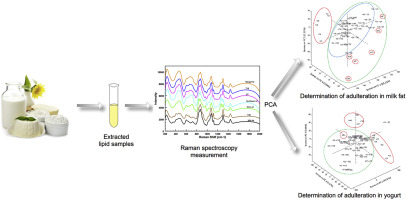当前位置:
X-MOL 学术
›
J. Food Drug Anal.
›
论文详情
Our official English website, www.x-mol.net, welcomes your feedback! (Note: you will need to create a separate account there.)
Raman spectroscopy coupled with chemometric methods for the discrimination of foreign fats and oils in cream and yogurt
Journal of Food and Drug Analysis ( IF 3.6 ) Pub Date : 2019-01-01 , DOI: 10.1016/j.jfda.2018.06.008 Nazife Nur Yazgan Karacaglar 1 , Tugba Bulat 1 , Ismail Hakki Boyaci 1 , Ali Topcu 1
Journal of Food and Drug Analysis ( IF 3.6 ) Pub Date : 2019-01-01 , DOI: 10.1016/j.jfda.2018.06.008 Nazife Nur Yazgan Karacaglar 1 , Tugba Bulat 1 , Ismail Hakki Boyaci 1 , Ali Topcu 1
Affiliation

|
The adulteration of milk fat in dairy products with cheaper non-milk based fats or oils is frequently encountered in the dairy industry. In this study, Raman spectroscopy with chemometric was used for the discrimination of foreign fats and oils in milk cream and yogurt. Firstly, binary mixtures of cream and oils (corn and sunflower oil), and vegetable fat blends which are potentially or currently used by the dairy industry were prepared. All fat or oil samples and their binary mixtures were examined by using Raman spectroscopy. Then, fat content of skim milk was adjusted to 3% (w/w) by the milk fat, external oils or fats, and binary mixtures, and was used in yogurt production. The lipid fraction of yogurt was extracted and characterized by Raman spectroscopy. The spectral data were then pre-processed and principal component analysis (PCA) was performed. Raman spectral data showed successful discrimination for about the source of the fats or oils. Temperature effect was also studied at six different temperatures (25, 30, 40, 50, 60 and 70 °C) in order to obtain the best spectral information. Raman spectra collected at higher temperatures were more intense. Obtained results showed that the performance of Raman spectroscopy with PCA was very promising and can be expected to provide a simple and quick way for the discrimination of foreign fats and oils in both milk cream and yogurt. Fermentation and yogurt processing affected clustering of fat samples by PCA, probably depending on some lipolysis or production of new products that can affect the Raman scattering. However, those changes did not affect differentiation of samples by Raman spectroscopy.
中文翻译:

拉曼光谱与化学计量学方法相结合用于区分奶油和酸奶中的外来脂肪和油
乳制品中的乳脂与较便宜的非乳基脂肪或油掺假在乳制品工业中经常遇到。在这项研究中,拉曼光谱与化学计量学被用于区分牛奶奶油和酸奶中的外来脂肪和油。首先,制备了乳品工业可能或目前使用的奶油和油(玉米和葵花油)和植物脂肪混合物的二元混合物。通过使用拉曼光谱检查所有脂肪或油样品及其二元混合物。然后,通过乳脂、外用油脂和二元混合物将脱脂乳的脂肪含量调整到 3% (w/w),并用于酸奶生产。提取酸奶的脂质部分并通过拉曼光谱进行表征。然后对光谱数据进行预处理并进行主成分分析(PCA)。拉曼光谱数据显示成功区分脂肪或油的来源。为了获得最佳光谱信息,还在六种不同温度(25、30、40、50、60 和 70°C)下研究了温度效应。在较高温度下收集的拉曼光谱更强烈。获得的结果表明,使用 PCA 进行拉曼光谱的性能非常有前景,有望为牛奶和酸奶中的外来脂肪和油的鉴别提供一种简单快捷的方法。发酵和酸奶加工会影响 PCA 对脂肪样品的聚类,这可能取决于某些脂解作用或会影响拉曼散射的新产品的生产。然而,
更新日期:2019-01-01
中文翻译:

拉曼光谱与化学计量学方法相结合用于区分奶油和酸奶中的外来脂肪和油
乳制品中的乳脂与较便宜的非乳基脂肪或油掺假在乳制品工业中经常遇到。在这项研究中,拉曼光谱与化学计量学被用于区分牛奶奶油和酸奶中的外来脂肪和油。首先,制备了乳品工业可能或目前使用的奶油和油(玉米和葵花油)和植物脂肪混合物的二元混合物。通过使用拉曼光谱检查所有脂肪或油样品及其二元混合物。然后,通过乳脂、外用油脂和二元混合物将脱脂乳的脂肪含量调整到 3% (w/w),并用于酸奶生产。提取酸奶的脂质部分并通过拉曼光谱进行表征。然后对光谱数据进行预处理并进行主成分分析(PCA)。拉曼光谱数据显示成功区分脂肪或油的来源。为了获得最佳光谱信息,还在六种不同温度(25、30、40、50、60 和 70°C)下研究了温度效应。在较高温度下收集的拉曼光谱更强烈。获得的结果表明,使用 PCA 进行拉曼光谱的性能非常有前景,有望为牛奶和酸奶中的外来脂肪和油的鉴别提供一种简单快捷的方法。发酵和酸奶加工会影响 PCA 对脂肪样品的聚类,这可能取决于某些脂解作用或会影响拉曼散射的新产品的生产。然而,



























 京公网安备 11010802027423号
京公网安备 11010802027423号